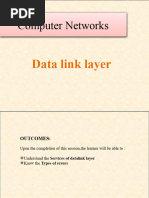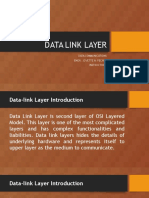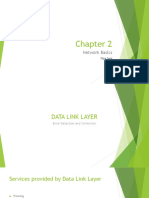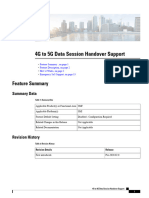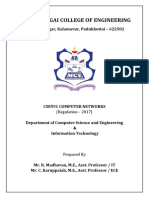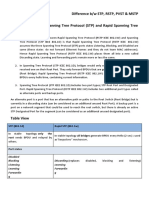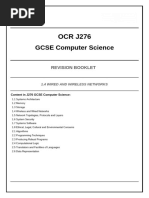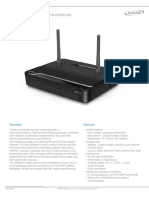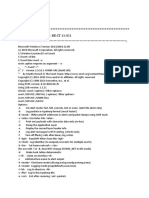0 ratings0% found this document useful (0 votes)
14 viewsData_Link_Layer_Lecture
Uploaded by
abdulrafayza01Copyright
© © All Rights Reserved
Available Formats
Download as PDF, TXT or read online on Scribd
0 ratings0% found this document useful (0 votes)
14 viewsData_Link_Layer_Lecture
Uploaded by
abdulrafayza01Copyright
© © All Rights Reserved
Available Formats
Download as PDF, TXT or read online on Scribd
You are on page 1/ 3
Data Link Layer: Introduction, Services, and Error Handling
1. Introduction to the Data Link Layer
The Data Link Layer is the second layer in the OSI (Open Systems Interconnection) model.
Its primary purpose is to handle communication between devices within the same local
network and ensure error-free transmission of data frames over the physical layer. It acts as
an intermediary between the physical layer and the network layer, providing node-to-node
data transfer and handling error detection and correction.
2. Sublayers of the Data Link Layer
The Data Link Layer is divided into two sublayers:
- **Logical Link Control (LLC)**: Responsible for identifying network protocols, error
checking, and flow control.
- **Media Access Control (MAC)**: Responsible for controlling how devices in a network
gain access to the data and permission to transmit it.
3. Services and Responsibilities
The Data Link Layer provides several essential services:
- **Framing**: Divides data into frames for easier handling and transmission.
- **Error Detection and Correction**: Identifies and rectifies errors in data transmission.
- **Flow Control**: Manages the rate of data transfer to prevent overwhelming the
receiving device.
- **Access Control**: Determines which device has control over the link at any given time.
4. Link-Layer Addressing
Link-layer addressing involves assigning physical addresses, also known as MAC addresses,
to devices on a network. These addresses allow devices within the same local network to
identify and communicate with each other uniquely.
5. Error Detection vs. Correction
Error detection and error correction are critical services provided by the Data Link Layer:
- **Error Detection**: Identifies errors in transmitted data but does not correct them.
Common techniques include parity checks and checksums.
- **Error Correction**: Not only detects errors but also corrects them. Forward error
correction (FEC) is an example of this approach.
6. Redundancy and Error Handling Techniques
Redundancy involves adding extra bits to data to help detect or correct errors during
transmission. Different error handling techniques include:
- **Parity Bits**: Simple error detection by adding a parity bit.
- **Checksums**: Calculates a value based on the data, which is checked at the receiving
end.
- **Cyclic Redundancy Check (CRC)**: Uses polynomial division to detect errors.
- **Forward Error Correction (FEC)**: Sends extra data to allow the receiver to correct
errors without retransmission.
7. Modular Arithmetic in Error Detection and Correction
Modular arithmetic plays a role in several error-detection and correction methods,
especially in techniques like checksums and CRC, where data is divided and processed to
detect discrepancies using modular calculations.
8. Checksum and CRC
- **Checksum**: An error-detection method that sums up data values and includes the
result with the transmission. The receiver recalculates and compares to detect errors.
- **Cyclic Redundancy Check (CRC)**: Uses polynomial division to detect errors in
transmitted data. It is a more robust method than a simple checksum, often used in network
and storage devices.
9. Forward Error Correction (FEC)
Forward Error Correction is an error-handling method that allows the receiver to detect
and correct errors without needing retransmission. FEC adds redundant data to the original
message, enabling error correction by analyzing patterns. Commonly used in situations
where retransmissions are costly or impractical, such as satellite or deep-space
communications.
You might also like
- All in One Premium Accounts and Cookies NEWNo ratings yetAll in One Premium Accounts and Cookies NEW20 pages
- 2-Data Link Layer and Media Access Control revisedNo ratings yet2-Data Link Layer and Media Access Control revised13 pages
- Computer Communication & Networking: Data Link ControlNo ratings yetComputer Communication & Networking: Data Link Control38 pages
- Error Detection and Correction in Data Link LayerNo ratings yetError Detection and Correction in Data Link Layer9 pages
- Computer Networks: Link Layer and Lans: Rajesh Palit, Ph.D. North South University, DhakaNo ratings yetComputer Networks: Link Layer and Lans: Rajesh Palit, Ph.D. North South University, Dhaka112 pages
- Chapter4_c25e22dbaa698b6874ea00cfe9ddb300_250413_125011No ratings yetChapter4_c25e22dbaa698b6874ea00cfe9ddb300_250413_12501144 pages
- Networking Programming with C++: Build Efficient Communication SystemsFrom EverandNetworking Programming with C++: Build Efficient Communication SystemsNo ratings yet
- Week 1 DCCN Introduction to Data Communication[1]No ratings yetWeek 1 DCCN Introduction to Data Communication[1]93 pages
- Mookambigai College of Engineering: Srinivasa Nagar, Kalamavur, Pudukkottai - 622502No ratings yetMookambigai College of Engineering: Srinivasa Nagar, Kalamavur, Pudukkottai - 62250235 pages
- Instructor DevNet Associate Packet Tracer ActivityNo ratings yetInstructor DevNet Associate Packet Tracer Activity36 pages
- CCNA2 - 1 - Configuring Network Devices and Introduction To RoutingNo ratings yetCCNA2 - 1 - Configuring Network Devices and Introduction To Routing60 pages
- Design and Implement Chat Program Using TCP/IP: April 2019No ratings yetDesign and Implement Chat Program Using TCP/IP: April 20197 pages
- List of TCP and UDP Port Numbers - WikipediaNo ratings yetList of TCP and UDP Port Numbers - Wikipedia77 pages
- Example - Generating A Server Certificate With OpenSSLNo ratings yetExample - Generating A Server Certificate With OpenSSL4 pages






